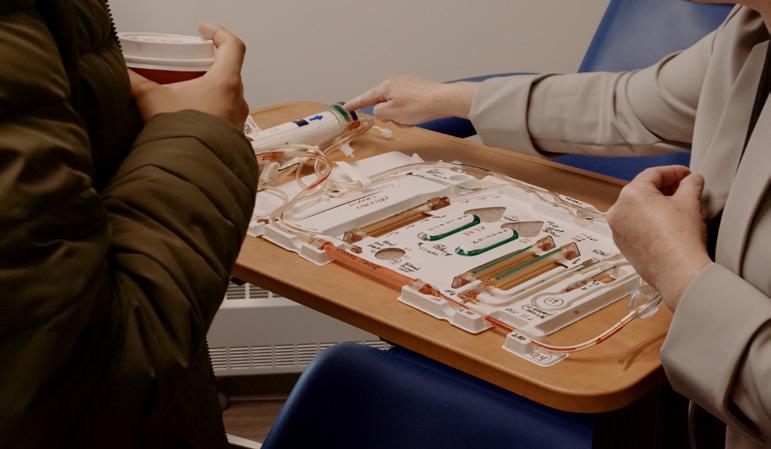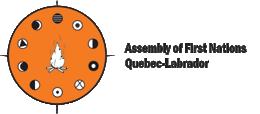TEA
















As many have said before – home is where the heart is. However, it’s hard at times to know where the heart is.
Recently, I traveled with my mom from Ottawa to Chibougamau. A place opened for her at a care home that’s located across from the hospital. Many of the residents at the home in Ottawa were sad she was leaving. But they were also happy she would be living in a place so close to her home, a mere 90 kilometres away compared to the 12-hour drive to her previous residence.
I understand their feelings as my mother has always been a special person. Her personality caused my high school friends to call her mom because of the way she treated them. She easily made friends everywhere she went throughout her life. She is happy in her new place as her cousin John Matoush and other Cree are residents there.
I escorted her from Ottawa to her new home. My brother Don packed up her belongings and brought them there. While he was doing that, I took the time to return to Mistissini and try to do a little hunting. Like many hunters it was not a good year as climate change saw ice disappearing, so geese were not landing in the usual spots.
Still, just sitting the blind was a time of peace and relaxation. It was also a time of connection. A connection to the land and ultimately to myself that I fully felt. Home is where the heart is, and I understood that for the first time in a long time.
The mental effects and stress of Covid and the isolation have been a problem for many, and I am no stranger to them. Being


in my true home was a moment of peace that I and others need these days. It’s not to say that my heart isn’t in Montreal with my two sons, but Mistissini has always been a place I loved.
I saw friends from the past, many who were happy to see I was among the living, and said they were surprised, in some cases even laughed. But all welcomed me with open arms. I met members of my extended family who I hadn’t encountered before. My family is huge so that wasn’t surprising, but it was welcome, nevertheless.
My nephew Darren and I visited my mom for Mother’s Day to see how she was. She was happy. Darren later gave me some Walleye, which I cooked. A bit
of teamwork that made my mother happy even as she shared with the other Cree residents to their delight.
Knowing where you come from is a special feeling that may be hard to explain but one that everyone knows anyhow if they are as lucky as I am. Just sitting on the deck looking outside of the home my parents built satisfied my sense of belonging, being and home. Memories inundated my soul with sadness, happiness and love more than I can ever hope to express.
My thanks to my uncles, aunts, cousins and nephew for all their love and help in making my return an experience that showed me that where the heart is a home and a real thing.
Will Nicholls DIRECTOR OF FINANCES Linda Ludwick EDITORS Lyle Stewart, Martin Siberok PRODUCTION COORDINATOR AND MANAGING EDITOR Randy Mayer
CONTRIBUTING WRITERS S. Orr, M. Labrecque-Saganash, P. Quinn, B. Powless DESIGN Emma Lindsay SALES AND ADVERTISING Danielle Valade, Donna Malthouse

THANKS TO: Air Creebec
CONTACT US: The Nation News, 918-4200 St. Laurent, Montreal, QC., H2W 2R2 EDITORIAL & ADS: Tel.: 514-272-3077, Fax: 514-278-9914 HEAD OFFICE: P.O. Box 151, Chisasibi, QC. J0M 1E0 www.nationnews.ca EDITORIAL: will@nationnews.ca news@nationnews.ca ADS: Danielle Valade: ads@nationnews.ca; Donna Malthouse: donna@beesum.com

SUBSCRIPTIONS: $60 plus taxes, US: $90, Abroad: $110, Payable to beesum communications, all rights reserved, publication mail #40015005, issn #1206-2642 The Nation is a member of: The James Bay Cree Communications Society, Circle Of Aboriginal Controlled Publishers, Magazines Canada Quebec Community Newspaper Assn. Canadian Newspapers Assn. Les Hebdos Sélect Du Québec. Funded [in part] by the Government of Canada. | www.nationnews.ca | facebook.com/NATIONnewsmagazine | Twitter: @creenation_news

Knowing where you come from is a special feeling that may be hard to explain but one that everyone knows anyhow if they are as lucky as I am.
The conservation movement was celebrated at the largest ever First Nations National Guardians Gathering in Ottawa May 9-11. Since the first gathering in 2016, the number of guardians programs across the country has quadrupled from 30 to more than 120.
Co-hosted by the Indigenous Leadership Initiative (ILI) and the new First Nations National Guardians Network, the event brought together over 250 guardians and 100 allies for three days of sharing circles, “small wigwam” workshops, ceremonies and entertainment.
“This was about showcasing the work and elevating the voices of guardians,” said ILI executive director Valérie Courtois. “It’s an initiative that changes lives.”
In 2014 the ILI was asked at that time to advocate for a national network, stable funding and recognition for guardianship as a profession. After a federal investment of $25 million in 2017 laid the groundwork for a national network, further funding of $173 million in 2021 demonstrated these programs’ success. The launching of an independent Guardians Network at COP15 last December enabled programs to access sustainable resources.
“We’ve proven the return on investment,” Courtois told the Nation. “The federal government has a duty to support the core capacity of these initiatives. Guardians are agents of reconciliation –it’s just as important to fulfill our responsibility to the land and waters as it is to each other.”
Federal leaders have acknowledged that this stewardship is essential for reaching international conservation commitments. Guardians are helping restore populations of at-risk species, manage threats like wildfires, improve land resiliency and support diverse cultural programs. Courtois is calling for permanent funding for guardian programs so that every Indigenous community that wants to can have one.
Their contributions were recognized at an awards ceremony on the Gathering’s first night before rousing performances from Halluci Nation and Twin Flames. Honorary lifetime awards were presented to Kaska Dena leader Dave Porter and Inuk Governor General Mary Simon.

The Collaboration Award was presented to Rodney Petawabano and Willie Loon from the Eeyou Istchee Land Keepers Program along with Innu Chief Mike Mckenzie in recognition of the Cree-Innu partnership to protect and share traditional harvesting of caribou. During these hunts, land keepers ensure that safety measures and tallyman protocols are followed.
“It’s a very natural exchange, promoting healthier relations with our neighbours,” said Cree Nation deputy executive director Melissa Saganash. “The Cree land keepers are kind of superstars when they show up on their skidoos with clearly identified uniforms. They’re there to support, not necessarily to be police.”
Courtois wanted the gathering to hear the Cree Nation’s inspiring governance and land guardianship evolution. Similar examples were shared in a panel with three young Dene women by Ethel Blondin-Andrew, the first Indigenous woman to be elected to Parliament. She told of building a moose-skin boat with Elders in the mountains then descending into the river valleys, which Courtois called “a mode of transportation essential in eras of the past but also an incredible symbol of reappropriation.”
Guardians described water monitoring, enforcement, collecting data with
drones and healing on the land. Several have grown from young apprentices into community leadership roles.
As working in remote environments can be isolating, many participants were reinvigorated by the gathering. Young storytellers from across the country are helping to carry these messages thanks to a media mentorship program through the ILI’s Land Needs Guardians campaign.
Storyteller Amberly Quakegesic said that while the cohort meets virtually five or six times a year, they truly bonded during this first in-person meeting. Provided with a camera, microphone and editing iPad, she interviewed storytellers from other guardian programs, connecting a supportive network of like-minded people.
“People are finding themselves through this program,” Quakegesic shared.
Growing up in a non-Indigenous family with an incomplete understanding of her history, guardianship strengthened Quakegesic’s ties to her culture and land. As program manager of the Wahkohtowin guardian program near Lake Superior, she now supports youth in activities like tree planting, moose tracking and harvesting birch syrup.
“It’s powerful for all our youth to know we exist because our ancestors were the ultimate survivalists who understood not taking more than you need,” asserted Quakegesic. “Being a part of these conversations is huge – it’s exposing me to things I need to know about. Now I spread the word like wildfire.”
The grand opening of the Home Dialysis Training Centre and Respiratory Clinic in Waskaganish was celebrated May 16 as a step toward bringing more Cree people with diabetes home to Eeyou Istchee. Ispeyimuunikaitmikw – the Hope Centre –will allow patients to conduct peritoneal dialysis and hemodialysis treatments from the comfort of their homes.
“This is a building of hope, that families can reunite and be together,” said Deputy Chief Samson Wischee at the inauguration before holding a moment of silence for those previously unable to return home for treatments. “This is a testament that working together we can make things happen.”
With soaring rates of kidney disease in the territory, the initiative will alleviate some of the need for dialysis patients ahead of the expected opening of the new Community Miyupimaatisiiun Centre (CMC) in 2026, which will position Waskaganish as a third hub for regional health services, along with Chisasibi and Mistissini.


Patients requiring treatment currently travel long distances, sometimes spending years away from their families in Montreal or Chibougamau. While home dialysis was first offered in Waswanipi in 2019 and later in Chisasibi, the Hope Centre is the first to be entirely operated by specialized nurses, eliminating the need for several weeks of training in Montreal.
“Whereas with hospital dialysis you do three times a week for four hours, with home dialysis you can work 9-to-5 and do your
dialysis in evenings after you’re done with your little ones,” shared Harriet Shem from Chisasibi. “I can relax at home with them and still travel with my machine by vehicle short distances.”
In collaboration with nephrologists at the McGill University Health Centre (MUHC) in Montreal, Waskaganish expedited this project by offering the old police station as a facility. Cree Health Boardexecutive director Daniel St-Amour said this gesture accelerated negotiations with the Quebec health ministry.
“We announced at the Waskaganish AGA in 2019 there was going to be a new CMC, but they wanted something sooner,” St-Amour told the Nation. “When we started talking about the training centre, it took a month before we got the ministry to approve it. I’ve never seen a project get approved that fast. The community is taking charge.”

MUHC nephrologists will determine whether patients qualify for home care. Some may not initially qualify due to overcrowded housing, physical disabilities or cognitive ailments that prevent working with the equipment, but families may help persuade the nephrologist by offering additional assistance to their loved ones.
Although the centre has three chairs available, St-Amour expects it can initially train one local patient per month and gradually offer service to those from other communities as more staff are trained. Personalized to the patient’s pace over four to six weeks, the training will show how to operate and maintain the machine until patients are completely autonomous.
Training nurses will accompany patients at home until they feel comfortable dialyzing on their own and will remain available to intervene afterwards in case of difficulties. Patients will continue to be welcomed at treatment units in Chisasibi and Mistissini.
This facility also provides respiratory therapists a better working space until the new CMC arrives, with new equipment like a “body box” to help assess lung function. The CMC will likely have five chairs for home dialysis training along with a full clinic, radiology services and hemodialysis lab so people won’t have to be sent down south.
“We’re going to need lab techs so it would be great if we have Cree interested in that trade to optimize the use of the hemodialysis chairs,” St-Amour explained. “There are a lot of interesting trades we have to fill. Nurses are very important, but they can’t do the work alone.”
While hemodialysis involves pumping blood to and from an artificial kidney machine, home care isn’t an option when conditions require proximity to hospital equipment. St-Amour admitted that while this initiative is a band-aid helping patients live longer and more comfortable lives, it doesn’t resolve the growing crisis of diabetes in Eeyou Istchee.
“One-third of the population has diabetes, which is very high,” said St-Amour. “We have to work on those 100 clients on a pre-dialysis list to ensure they can stay off hemodialysis as long as possible. Doing prevention, instead of having hemodialysis
within two years, you can go five or maybe 10 years.”
The prevalence of Type 2 diabetes in the region has steadily increased since the early 1980s, when it impacted 1.5% of the population. By 2016, the chronic disease affected 26.7% of Cree over age 20, a rate 3.6 times higher than the general population of Quebec. The health board emphasizes staying active, reducing stress and eating nutritious food to prevent or delay diabetes.
“It’s great to have a home dialysis program happening now but bringing more machines is not what we want to make our primary focus,” said CHB chairperson Bertie Wapachee. “There are a number of potential patients at the doorstep of dialysis – if we don’t do anything we’ll just be repeating ourselves over and over again to get more machines.”
Wapachee foresees a coming diabetes campaign emphasizing taking responsibility for one’s own health. While diabetes is exacerbated by systemic issues like overcrowded housing and food security, it can be mitigated by exercise on the land and choosing vegetables over sugary snacks.
“We’ve been promoting shared responsibility to improve every individual’s mental and physical health,” Wapachee explained. “If we don’t look after our health, we expect more people to move down south for dialysis. We’re almost waiting to lose lives – we must change that. We’ll do everything we can so every one of them returns home.”

Contact us for details:
Donna Malthouse: donna@beesum.com

Danielle Valade: ads@nationnews.ca
The Nation issue in celebration of National Indigenous Peoples Day is coming out on June 16th.
It would be wonderful to have your message and wishes included in the Nation, to celebrate and honor the pride and culture of First Nations on this very special day.
DON'T MISS THIS ISSUE!!
Cover Issue: June 16
Deadline to book space/send material: June 2
While Whapmagoostui is still only accessible by air or water, that hasn’t prevented a growing number of community members from purchasing cars and trucks to get around. Now the band is planning to open a gas station that honours residents’ status cards for tax exemptions on gas and diesel.
These tax exemptions aren’t available at the public gas station owned by the Fédération des coopératives du Nouveau-Québec (FCNQ), located in the neighbouring Inuit community of Kuujjuarapik, where gas and diesel are often at least a dollar more costly than down south.
“Twenty years ago, they could count the number of car owners with one hand,” economic development officer Sidney Orr told the CBC. “Today, everybody’s got an SUV or a pickup truck. For petroleum, you have to have your gasoline or heating oil delivered on the category 1A lands in order to be tax exempt.”
Efforts to finalize a site for the band-owned gas station are currently underway.
With a growing number of derelict cars around town, a vehicle-repair shop is next on the wish list.
“Everybody bought a vehicle and now we have to learn off YouTube how to repair them,” said Orr. “It’s nice to drive around but keeping them driving is a different story.”
Indigenous leaders are calling for the resignation of the Coalition Avenir Québec MNA for Abitibi-Est, Pierre Dufour, after he suggested that several Indigenous women lied about being sexually assaulted by Val-d’Or police officers.
Speaking about homelessness and programs offered by the provincial government during a May 15 city council meeting in Val-d’Or, Dufour told the council that the 2015 Radio-Canada investigation into physical and sexual assaults of Indigenous women in Val-d’Or by police had contributed to the problem. He said the Enquête program was “full of lies” and attacked “police officers that were very honest.”
“This report won awards, but it created a split between the police service and the community, which didn’t protect the police officers afterward,” Dufour claimed. He later posted that he misspoke and made the comments during an emotional moment.
to disclose abuse during the Viens Commission. Anishnabe Nation of Lac Simon Chief Lucien Wabanonik suggested Premier Francois Legault’s silence following these offensive remarks is fuelling racism in the province.
Val-d’Or Native Friendship Centre executive director Édith Cloutier called the comments “unacceptable” and “disgraceful”. One woman who had been interviewed for the program told her it was like living through post-traumatic syndrome.
“It actually creates a socially tense climate that revives all of those old wounds that we are trying to heal,” said Cloutier, adding this “direct attack to the truth of Indigenous women” could discredit the testimony of the victims who came forward.
The Assembly of First Nations Quebec-Labrador called the comments contemptuous of the courageous women who came forward
“The only honourable thing (Dufour) could do is to resign to make room for a well-intentioned and compassionate leader who finds solutions rather than causes chaos,” said AFNQL Chief Ghislain Picard. “The Premier of Quebec must clearly denounce the comments made by this member and show him the door.”
The Native Women’s Association of Canada said Dufour’s comments “are a slap in the face to Indigenous people across Canada, especially to survivors of abuse.”
Grand Chief Mandy GullMasty affirmed the Cree Nation’s support to Val-d’Or Mayor Céline Brindamour after the incident, calling the comments “extremely irresponsible, divisive and confusing, given the party’s insistence that it is not the words that matter but rather the actions when it comes to systemic discrimination.”
It was like living through post-traumatic syndrome


Astudy suggested by Cree and Inuit leaders has demonstrated that essential oils from dwarf Labrador tea, or Rhododendron subarcticum, are effective against the parasite that causes drug-resistant malaria.
Labrador tea is a remedy long used by Indigenous peoples to treat a range of ailments, but a smaller shrub producing a particularly aromatic brew is only found in harsher subarctic environments near Whapmagoostui. Its chemical composition and potential antimicrobial applications were relatively unstudied the recently published findings in the ACS Omega scientific journal.
“The dwarf Labrador tea is very much used in our community every day,” said Joshua Kawapit, Whapmagoostui’s communications officer. “When I get sick, that’s the first medicine I’ll resort to as a form of detox. We wanted to know its properties and if it can cure other things we don’t know of.”
Université Laval chemist Normand Voyer, who has developed a relationship with Kawapit and other community members over several years, proposed the research study to help validate the importance of local medicinal plants. People in Whapmagoostui and neighbouring Kuujjuarapik wanted to understand whether the dwarf Labrador tea might become toxic or less effective with higher usage.
“They were interested to see the variability of the medicinal composition,” Voyer told the Nation. “We said that’s a cool idea. If that can show the rest of the world that Nunavik is an amazing place filled with molecular treasures, that would be my small contribution to showing the importance of respecting the land and communities living on that land.”
Believing Northern Quebec to be “an amazing scientific playground” with a unique ecosystem, Voyer said he intends to devote the rest of his career to demonstrating this value at the molecular level. By revealing hidden treasures in Nunavik tundra or Huron-Wendat forests, he hopes to support land-conservation efforts.
The Centre for Northern Studies at Université Laval has research stations across northern Quebec. Kawapit noted that scientists may ask communities for permission to conduct field work but rarely share their results. When consulting with the band council in 2019, Voyer promised to present his team’s work with the community first.
“We have an amazing relationship with the Whapmagoostui First Nation and are really indebted they’re trusting us,” said Voyer. “It’s a privilege, honestly, to discuss nation-to-nation. We’re in direct contact with traditional knowledge keepers and healers. We’re also working on a small booklet that could be used to talk about traditional medicine in schools.”
Voyer’s team extracted essential oil from leaves gathered in Nunavik, eventually identifying 53 compounds through gas chromatography, mass spectrometry and flame ionization detection. Results showed that ascaridole in the oil was the primary component acting against malaria-causing parasites.
The molecule ascaridole is found in different plants around the world, including one used by Indigenous communities in Mexico for its anti-parasitic properties. While malaria is a mosquito-borne disease that kills nearly a million people primarily in tropical regions every year, it shares certain properties with other types of parasites.
The study’s results, which emphasized protecting rapidly changing northern ecosystems, were presented to the Whapmagoostui council last year. The community is interested in documenting the impacts of invasive shrubbery that can prevent sunlight from reaching lower plants and lichens.
“We’re working with a dwarf birch tree that’s progressing north very rapidly,” explained Voyer. “Nothing is known about this shrub. We’re trying to find out if there’s anything useful that could be transferred to the Cree and Inuit so they could potentially harvest it and develop a local economy.”
“It demonstrates the impact some of these natural medicines can have around the globe,” Voyer explained. “When you eat raw meat, you can get several different parasites. Indigenous communities know how to take care of themselves with medicine to treat parasites that enter their food chain – another lesson we’re learning from traditional knowledge.”
While the study’s results suggest that molecules from dwarf Labrador tea could be extracted and reproduced in the lab to develop a malaria treatment, Voyer emphasized he has no interest in patenting or profiting from this research. However, he supports potential commercial applications initiated by the Cree Nation if it so chooses.
“If the World Health Organization synthesizes that to develop a medicine, they would have to sign agreements with the Cree Nation to recognize their contribution,” said Voyer. “There is absolutely no idea for harvesting these plants to save the Africans from malaria. We’re trying to show nature is providing us clues to treat malaria with natural substances.”
Research on dwarf Labrador tea is likely to continue further north, collecting samples in different seasons to determine the chemical composition’s variability, which can significantly influence its medicinal properties. While essential oil is easier to study, the team now wants to follow local recipes with community members to document how the herbal tea is traditionally prepared, analyzing its chemistry to support tradition knowledge.
Past studies conducted with the Cree Nation have shown regular Labrador tea extracts to effectively treat symptoms associated with diabetes. It’s been used to counteract all types of pain, including respiratory, digestive and kidney problems, rheumatism, scurvy, easing labour and purifying blood. However, some sources suggest concentrated doses could be toxic.
Voyer looks forward to resuming his research and recounted fond memories of playing baseball with summer students and local children. As the principal organizer of the Quebec Indigenous Science Fair in March, he was impressed by presentations from budding scientists from Chisasibi and Mistissini.
Kawapit believes the collaboration is inspiring more of his community’s youth to consider science careers. Asserting that the pharmaceutical industry caused substantial loss of traditional medicine practices, he said he’s not surprised this study is confirming health benefits found in local plants.
Results suggest that molecules from dwarf Labrador tea could be extracted and reproduced in the lab to develop a malaria treatment















The Cree Women of Eeyou Istchee Association (CWEIA) has initiated a new regional program called Manchadauu, which means “let’s build”, to help families affected by domestic violence through strength provided from traditional teachings.
Project coordinator Adrian Rabbitskin-Bullfrog assumed his position in January, working with CWEIA wellness coordinator Susan Mark. Together with local women’s and men’s associations, he will visit communities following Goose Break to help connect impacted individuals with Elders.

“We’re approaching domestic violence through the teachings of the Elders,” Rabbitskin-Bullfrog told the Nation. “It’s to be comfortable in knowing they can go to the Elder whenever they feel like sharing their thoughts and feelings, and to better understand the meaning of traditional shelters and dwellings.”
Rabbitskin-Bullfrog explained that coastal and inland communities have different cultural dwellings that are built according to the season. As each pole of a teepee or other structure has a specific Cree name and purpose, understanding which pole represents the individual can support traditional healing pathways.

 by Neil Diamond
by Neil Diamond

The people of Waskaganish have spoken and voted yes to allow the sale of alcohol at their restaurants, tournaments, wedding receptions and other special events in a referendum held May 23. Before the vote, I asked several men and women on the street for their opinion on this matter.
“It’s time to look at alternatives because the community has been under prohibition for a long time, and it’s proven that it doesn’t work. It’s not a problem when you use alcohol responsibly, it’s when you abuse it that it creates problems for your family, for the community in general. If we can educate people to use it responsibly it would be better. I think that’s what the community wants to do with this and because our young people, wherever they go in this world, alcohol is always going to be present and if we give them the life skills on how to deal with it and how to use it responsibly, I think it’s best for them.”
– Charles J. Hester
“I think it’s a good idea so people will learn how to drink. I think people who cause trouble should be banned from buying it for a month like they do in Whapmagoostui. Maybe they can control alcohol instead of alcohol controlling them. We can’t stop alcohol. It’s all over the world.”
– Glen Wadden“If the band wants to legalize alcohol sales, they should go by the laws that are already in place in Quebec. If we go the way we are it’s going to make the situation worse with more break-ins into people’s houses, into other establishments and cause more ruckus in our community. It would be better if we followed Quebec’s alcohol laws.”
– Denny Dannrath“There’s already alcohol and alcohol abuse. It’s been going on like that for years. It’s good to try different ways to try and control it at least. There’s a lot of drinking of hard liquor so maybe they
won’t drink so much of that. They’ll just get full on beer [laughs]. I heard of a community down south that put up a bar and now you don’t see people drunk on the streets. It changed the way they drink. They no longer binge drink, they just drink socially.”
– Stacey Bear“I think they’re moving too fast on this. There are resolutions that were passed at previous meetings and round tables that haven’t been implemented. But it looks like they’re moving too fast on this one.”
– Marjorie Blackened“People don’t know how to drink socially. And after what happened here recently [a shooting death], there’s a lot of grief in the community. It would be wise for the band to look at that issue first.”
– David Erless“Alcohol made our parents and grandparents suffer. Now we see it’s getting out of hand. It’s hard on all the resources we
have in our community. It’s tiring for the police, social services, and teachers. The good side of it is that there are people who drink responsibly and who can control it. But it’s the white people. I don’t know of any Crees who can do that. I haven’t seen any who drink just a bit then go to bed. It’s getting worse here and in Val-d’Or.”
– Rita Macleod“I don’t have a problem with that as long as it’s for adults. It has to be in a secure and safe environment. And the people working there [serving alcohol] have to be more informed about the whole picture here. To be informed of any trauma. Now that we are more informed about trauma, we understand that alcohol abuse is a symptom.”
– Charles EsauThe results for the Waskaganish Alcohol Referendum are in at print time and they voted yes.


Mistissini-based artist and musician Ayden Gray, aka Sinematic, discusses his newest song, “War With Myself”, which addresses the inner turmoil he struggles with. The song’s theme is about taking responsibility and how to stop blaming others for one’s emotions and actions. With its release, Gray hopes to raise awareness about mental health and well-being.
What inspired you to write “War With Myself”?
Music was always an outlet for me when dealing with my emotions, thoughts and whatever I’m going through. I start out with the music first when creating songs and the lyrics follow second. Once I had the skeleton of this song, I was struggling with what to say and how I should put words together. I had this feeling of self-doubt and thoughts about why I am not doing anything right. I thought maybe it shouldn’t be a song after all because nothing was coming out of it.
After listening to it over and over again, which usually helps a lot, the words flew out of my mouth: “I can’t go on, fighting like this, always feeling, alone and worthless.” I started to write that down and the rest came after. It took me a few days to write the lyrics for the whole track and be happy with it. Being stuck and thinking I can’t do this became the inspiration of the song. What was your creative process for this song?
For me to get into a creative space, I always start out at the piano. I pluck around for ideas and sometimes get into playing around and melodies flutter out. I came up with the chorus on the
piano and later worked around that with synths and strings. I love having a classical sound in every song I make with hints of electronic sounds and of course, with a rock, metal sound backing it all up. I connected with a talented musician from Italy named Loris Castiglia who helped me finish the song by recording guitars, drums and bass. As of now, we have worked on a handful of songs.
What is the message you want to convey with “War With Myself”?


I love to make my music universal and open for interpretation. I love the fact that the music I make can be part of any race, any gender, any belief and anyone who can relate to certain things in different ways. Same sounds, different feelings, same words, different meanings. Like an abstract painting, you see one thing, find another. A world where we all can get lost but still brings us together.
This song specifically is about putting a stop to that kind of mindset that makes us believe we are not good enough and we should learn to take responsibility of our own actions, feelings and thoughts. We need to stop blaming others for our own mistakes and stop making ourselves look like the victim and for once look in the mirror and finally see that we can change to be better. Once you point a finger at someone you don’t realize you’re pointing three more back at yourself. We can let go of that kind of hate and learn to better control our emotions. We need to start blaming ourselves for how we feel cause we all can grow.
How does this song differ from your previous work?
The previous songs I created are about my past, personal experiences I’ve been through whether it was work, friends and family, or inspirations from dreams and stories. This song is about that mental state where I feel like I’m not important, feeling insignificant and valueless. I know most of us at some point in our lives feel that feeling like we don’t matter. We hear a voice in
our head that tells us we don’t belong, we’re not good enough and not talented enough.
We sometimes lean towards drugs and/or alcohol as a shoulder to cry on because we can’t talk to anyone about it. Some of us even lean towards our families for help, but sometimes they’re the ones who hurt us the most. The only one who can help us is ourselves and I hope we all can just stand back up when we’re feeling down and learn it’s okay to feel this feeling but know that we can’t let it take control of our lives.
What was the most challenging aspect of creating this song?
Writing the lyrics for this song was the most challenging part. I’m very passionate about music and all the lyrics in my music do have meaning. I can’t write lyrics just to say something, I can’t just make stuff up and be like “okay whatever it’s good enough.” Every word I sing has a meaning and if I can’t think of something, I will take two to five years if necessary to finish a song. Sometimes it can be easy, and the words will flow right out of me, and when that happens, I know it’s meant to feel this way. “War With Myself” was tricky but I wrote it for myself, to myself but I also wrote it in a way that others can hopefully relate to it.
What do you hope your fans take away from “War With Myself”?
I hope people can listen to this song and feel empowered, inspired and, most importantly, learn to take ownership of their own actions. This song is not only about me but it’s about taking responsibility and not to feel ashamed about it. We shouldn’t have the need to hurt anyone’s feelings just because we’re having a bad day. We can change it all if we just pick ourselves back up. I hope listeners can become more mindful of others and themselves and let go of pride and ego and fit comfortably to be themselves no matter what it looks like to anyone. A shattered mirror can still reflect light.
personal battles revealed in new single “War With Myself”
Your place to get great gift ideas for your family or business. Come and browse our shop. There’s a lot to see. We can also serve you through Facebook chat. For online orders, we accept EMT for payment or we can process credit card or visa debit over the phone.
We also accept PO’s from entities and companies. If you need a quote, please send us a message at ouwahstore@gmail.com






Here’s another edition of the Nation’s puzzle page. Try your hand at Sudoku or Str8ts or our Crossword, or better yet, solve all three and send us a photo!* As always, the answers from last issue are here for you to check your work. Happy hunting.

You can find more help, tips and hints at www.str8ts.com
Previous
- Medium
No.
For many strategies, hints and tips, visit www.sudokuwiki.org
Now let’s get this straight. First the Canadiens go down, then the other Canadian team founders, then they all are gone. Who’s left to cheer for? Well, a few First Nations hockey players, that’s who.

Now another Canadian favourite has left a few hunters scratching their heads, huh? What happened to the fabled Canada goose migration this year? How to dress in camouflage and stay warm in this year’s unusual cold spell?
Spring? It’s lasting and lasting, snowfall after snowfall. Not in any blizzard style, but more of the weather for snow geese which keeps us outdoors and freezing in the name of getting more meat for the fridge.
This spring is a bit of an awkward start to what seems to be a good year. But now we know the dire news, it’s going to be a cold summer. I guess we have to think of new ways to keep entertained on those upcoming cold summer nights.
A new game could be just the thing to start. Let’s say, softball made from snow? The big difference is that when you miss you can still run to first base and the catcher can throw the snowball at you and you’re out, otherwise you can stay on first base.
Or kite flying could be used to battle those pesky drones, which are everywhere now. Or maybe take up some falcon training to be a Ferrari retriever of the skies, fetching your ptarmigan or ducks for you. If you upgrade to a golden or bald
eagle, you could get your geese easily. Or maybe a small goat if you can afford one, to feed the carrion eaters of the air.
Since it will be a cold summer, maybe a triathlon to keep the body warm. With the cold swim kept to a minimum due to the possibility of getting hypothermia and croaking during the first kilometre of the race.
A good old square dance competition could bring out the heat in everyone, except let’s try a dance marathon in orer to break a few records while doing the Fort George Reel. I believe the record is just shy of 125 hours, so that’s a Monday to Friday folks. Consider getting shoes that fit well and are comfortable and don’t wear anything made of polyester.
And if the forecast calls for rain, just do indoor stuff like rearranging your furniture or decluttering the closets. You’d be surprised at what you find again and can’t part with, creating a vicious cycle of
hoarding, knowing that they will never be of any value as a collectable. Think of all those Lego pieces you bought last century that have a knack for getting under your foot. I could use a robot vacuum cleaner to warn me of anything that could cause me to curse and frighten the children.
Or you could always go fishing. The fish don’t care, they’re wet anyway.
Speaking of fishing, I’d like to see more than just fish getting caught. I’d like to witness some speedy fish fileting skills or some cooking contests, especially ones for the best smoked fish. The best part of any cooking contest – being one of the judges.
All that should round out a short summer season. At least the risk of forest fires isn’t as high as when it’s hot enough to fry an egg on your car rooftop. This is just a blessing in disguise, or in this case, in the skies.

This is just a blessing in disguise, or in this case, in the skies.
Ispent the past few days inside my garage getting my old motorcycles ready for another season of riding. I enjoy working on my classic rides –including a 1998 BMW K1200RS, a 1992 Yamaha FJ1200 and an even older 1978 Honda GL1000 Goldwing. I’ve had these bikes for years and as they age, they need more and more servicing to keep them running well.
I am very much at home working in my 1950s-era garage filled with all sorts of tools and bits and parts I’ve collected over the years. There is something comforting and nostalgic about the old wooden building as it reminds me of my dad Marius’s garage in Attawapiskat.
Dad’s garage was a classic mechanics environment and it always appeared untidy and disorganized. It was stuffed with engine parts, scrap metal, rope, chains, plastic parts, tools, gears, bottles of oils and fluids. There were old boxes, containers and buckets filled with nails, screws, bolts and fasteners of every size and kind.
But my dad knew exactly where to find everything he needed in this confused environment. Only when my brothers or I would take the time to organize and tidy up did everything become accessible to anyone else. This made dad happy, and it gave us a taste for appreciating that old garage and all the precious things it housed.
There were no small-engine mechanics around so people like my dad had to learn to service motors and machinery on their own. As kids, my siblings and I grew up learning about “Pee-mah-eh-kan” –the thing that turns – our Cree word for wrench or screwdriver. There was also the word “Mah-koosh-chee-gan” – the thing that clamps – the Cree word for pliers.
Dad also collected old farm tractors as well as implements and attachments to make use of those old machines. At one point he bought an aging sawmill and a planing machine that could be powered with the power take-off (PTO) of a tractor. He rebuilt, serviced and maintained all these things on his own.
chains, ropes and brute force to move the heavy metal pieces around.
All my dad had in terms of documentation were a couple of pages someone had given him with diagrams of the inner workings of the metal parts. Tools lay scattered around everywhere and no one kept track of the nuts, bolts and screws that came off. Yet, these fasteners and bits magically came back together as the show moved on.
The cast of characters all provided their tidbits of knowledge so that the old tractor was slowly resurrected from the dead. The progress through trial and error and featured much excitement, verbal collaboration and laughter.
The play was often interrupted as new challenges arose and frustration ebbed and flowed as either something went wrong, things got lost or a part just didn’t fit. Cree mechanics share one thing in common with all mechanics in that they vent with a lot of creative swearing in our Cree language.

When his tractors broke down with major problems, he sought the expertise and skill of his nephew Robert Kataquapit, who was a self-taught mechanic and capable of disassembling, fixing and rejuvenating old trucks and cars with nothing but a basic tool kit and a vehicle ramp made of logs. As curious kids, we often went by his outdoor shop to watch him remake whole engines or transmissions.
One summer, dad hired Robert to repair the transmission on his John Deere farm tractor. We kids watched from the sidelines as dad, Robert, my older brothers and several Elders dissected the old green tractor. It was like watching a play set on the stage of characters and machinery. The group used blocks, logs,
These past few nights in my rustic garage I was relived those days back in Attawapiskat that starred Robert, my dad, Elders and my siblings in the quest to bring some machine back to life. The smell of the oil, the grease on my palms and the feel of the cold metal tools in my hands took me back to those early days.
Now I had plenty of help with a shop manual, tutorials on YouTube and endless mechanic forums concerning my Honda. Still, I owe any skill I have to all those self-taught Cree mechanics who taught me that you must be willing to learn from your mistakes, be ready to take a risk and always have the enthusiasm and self-confidence to maintain your own machines.
You must be willing to learn from your mistakes, be ready to take a risk and always have the enthusiasm and self-confidence to maintain your own machines.


- Elected officials
Chiefs/Grand Chiefs, Vice-Chiefs and board presidents: Next cohort: November 16, 2023

Councillor/Chiefs and board administrators: Next cohort: December 7, 2023
- Entrepreneurs Next cohort: November 22, 2023
- Managers Next cohort: November 29, 2023
- Women and leadership Next cohort: October 30, 2023
*Places are limited
TO FIND-OUT MORE AND SUBMIT YOUR APPLICATION GO TO: FOLLOW US
fnee.ca/programs



